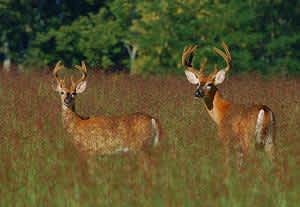Population Models Help Biologists Manage Deer Herds in Kentucky

“Models enable deer managers to input information to track population trends,” said Tina Brunjes, deer and elk program coordinator for the Kentucky Department of Fish and Wildlife Resources. “The two basic questions are: how many deer were born and how many died.”
Models are objective, mathematical indicators of populations. They provide herd managers with a better understanding of the factors that cause a population to increase or decrease.
“When you boil it down, you have to know what’s driving the population,” said Brunjes. “You need to factor in the birth rate, weather, quality of habitat and mortality; be it from hunting, or compensatory mortality such as accidents, disease, coyote predation of fawns, or vehicle/deer collisions.”
Before computers, deer managers used pens, paper and calculators to compute statistics on deer herds. Today, they use spreadsheets.
Kentucky’s deer herd is managed on a county level, so there are 120 sets of data to be analyzed each year after the close of hunting in January.
“Population models need a large data set to be effective,” said Brunjes. “They are used for large, landscape level monitoring, but are not suited for 1,000-acre deer leases.”
A good model detects population trends quickly, after factoring in all the intangibles, which includes crop damage complaints, deer/vehicle collisions and the number of landowners or hunters expressing concerns about deer numbers.
“Our population model gives us an estimate of deer per square mile,” said Brunjes. “From that number, we have a pretty good idea if the population density is over, under or on target, based on the county’s zone status.”
An understanding of the impact of many factors is needed to recommend season lengths and bag limits.
In 1986, after evaluating several computerized deer population simulation programs, Kentucky deer managers selected the program Deer Camp, which used harvest data from previous seasons to generate estimates of the number of deer that would be present in a county when the next season opened.
Deer Camp is one of several deer population models that have been used in recent decades by deer managers across the country. Wisconsin, for example, has used the SAK (Sex-Age-Kill) deer population model since the 1960s.
In 2002, Kentucky deer managers adopted the Downing Reconstruction model. Brunjes said this model is used in nearly all the southeastern states. Harvest data enables managers to determine the age and sex composition of the herd and also tracks recruitment, or the number of fawns per doe.
Deer herds don’t go through boom or bust cycles. “It takes years for management changes to be detectable,” said Brunjes. “Managing deer herds by regulated sport hunting is a long term commitment.”
These management models provide a long term benefit to Kentucky hunters.
Author Art Lander Jr. has been writing about the outdoors since the 1970s. He is a staff writer for Kentucky Afield Magazine.

